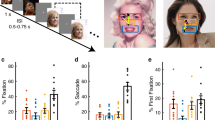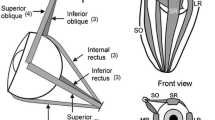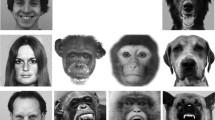Abstract
Face perception plays a crucial role in primate social communication. We have investigated the pattern of eye movements produced by rhesus monkeys (Macaca mulatta) as they viewed images of faces. Eye positions were recorded accurately using implanted eye coils, while neutral upright, inverted and scrambled images of monkey and human faces were presented on a computer screen. The monkeys exhibited a similar eye scan pattern while viewing familiar and unfamiliar monkey face images, or while viewing monkey and human face images. No differences were observed in the distribution of viewing times, number of fixations, time into the trial of first saccade to local facial features, and the temporal and spatial characteristics of viewing patterns across the facial images. However, there was a greater probability of re-fixation of the eye region of unfamiliar faces during the first few seconds of the trial suggesting that the eyes are important for the initial encoding of identity. Indeed, the highest fixation density was found in the eye region of all the face images. The viewing duration and the number of fixations per image decreased when inverted or scrambled faces were presented. The eye region in these modified images remained the primary area of fixation. However, the number of fixations directed to the eyes decreased monotonically from the upright images through the inverted versions to the scrambled face images. Nonetheless, the eyes remain the most salient facial substructure regardless of the arrangement of other features, although the extent of salience which they attain may depend both on the low level properties of the eyes and on the global arrangement of facial features.








Similar content being viewed by others
References
Anderson JR (1998) Social stimuli and social rewards in primate learning and cognition. Behav Process 42:159–175
Andrew RJ (1963) Evolution of facial expressions. Science 142:1034–1041
Andrews TJ, Coppola DM (1999) Idiosyncratic characteristics of saccadic eye movements when viewing different visual environments. Vision Res 39:2947–2953
Antes JR (1974) The time course of picture viewing. J Exp Psychol 103:62–70
Attneave F (1954) Some informational aspects of visual perception. Psychol Rev 61:183–193
Bentin S, Deouell LY (2000) Structural encoding and identification in face processing: ERP evidence for separate mechanisms. Cogn Neurophysiol 17:35–54
Bentin S, Allison T, Puce A, Perez A, McCarthy G (1996) Electrophysiological studies of face perception in human. J Cogn Neurosci 8:551–565
Bentin S, Sagiv N, Mecklinger A, Friederici A, von Cramon YD (2002) Priming visual face-processing mechanisms: electrophysiological evidence. Psychol Sci 13:190–193
Biederman I (1987) Recognition-by-components: a theory of human image understanding. Psychol Rev 94:115–147
Biederman I, Mezzanotte RJ, Rabinowitz JC (1982) Scene perception: detecting and judging objects undergoing violation. Cognit Psychol 14:143–177
Brown MW, Bashir ZI (2002) Evidence concerning how neurons of the perirhinal cortex may effect familiarity discrimination. Philos Trans R Soc Lond B Biol Sci 357:1083–1095
Bruce C (1982) Face recognition by monkeys: absence of an inversion effect. Neuropsychologia 20:515–521
Bruce V, Young A (1986) Understanding face recognition. Br J Psychol 77:305–327
Bruce V, Young A (1998) In the eye of the beholder. Oxford University, New York
Carmel D, Bentin S (2002) Domain specificity versus expertise: factors influencing distinct processing of faces. Cognition 83:1–29
Carpenter RH, Williams ML (1995) Neural computation of log likelihood in control of saccadic eye movements. Nature 377:59–62
Cooper EE, Wojan TJ (1996) Differences in the coding of spatial relations in faces and objects. Invest Ophthalmol Vis Sci 37:177
Dittrich W (1990) Representation of faces in longtailed macaques (Macaca fascicularis). Ethology 85:265–278
Eimer M (2000) Event-related brain potentials distinguish processing stages involved in face perception and recognition. Clin Neurophysiol 111:694–705
Emery NJ (2000) The eyes have it: the neuroethology, function and evolution of social gaze. Neurosci Biobehav Rev 24:581–604
Guo K, Benson PJ (1998) Involuntary eye movements in response to first- and second-order motion. Neuroreport 9:3543–3548
Henderson JM, Hollingworth A (1999) High-level scene perception. Annu Rev Psychol 50:243–271
Jolly A (1972) The evolution of primate behavior. Macmillan, New York
Keating CF, Keating EG (1982) Visual scan patterns of rhesus monkeys viewing faces. Perception 11:211–219
Kleinke CL (1986) Gaze and eye contact—a research review. Psychol Bull 100:78–100
Kowler E, Pizlo Z, Zhu G, Erkelens CJ, Steinman RM, Collewijn H (1992) Coordination of head and eyes during the performance of natural (and unnatural) visual tasks. In: Berthoz A, Vidal PP, Graf W (eds) The head-neck sensory motor system. Oxford University, Oxford, pp 419–426
Kreiger G, Rentschler I, Hauske G, Schill K, Zetsche C (2000) Object and scene analysis by saccadic eye-movements: an investigation with higher-order statistics. Spat Vis 13:201–214
Kyes RC, Candland DK (1987) Baboon (Papio hamadryas) visual preferences for regions of the face. J Comp Psychol 101:345–348
Leder H, Bruce V (1998) Local and relational aspects of face distinctiveness. Q J Exp Psychol A 51:449–473
Mackworth NH, Morandi AJ (1967) The gaze selects informative details within pictures. Percept Psychophys 2:547–552
Marler P (1965) Communication in monkeys and apes. In: DeVore I (ed) Primate behavior. Holt, Rinehart & Winston, New York, pp 544–584
Maurer D (1985) Infant's perception of facedness. In: Field T, Fox N (eds) Social perception in infants. Ablex
McKelvie SJ (1976) The role of eyes and mouth in the memory of a face. Am J Psychol 89:311–323
Mendelson MJ, Haith MM, Goldman-Rakic PS (1982) Face scanning and responsiveness to social cues in infant rhesus monkeys. Dev Psychol 18:222–228
Nahm FKD, Perret A, Amaral DG, Albright TD (1997) How do monkeys look at faces? J Cogn Neurosci 9:611–623
Noton D, Stark L (1971) Scanpaths in saccadic eye movements while viewing and recognizing patterns. Vision Res 11:929–942
Parr LA, Winslow JT, Hopkins WD (1999) Is the inversion effect in rhesus monkeys face-specific? Anim Cogn 2:123–129
Parr LA, Winslow JT, Hopkins WD (2000) Recognizing facial cues: individual discrimination by chimpanzees (Pan troglodytes) and rhesus monkeys (Macaca mulatta). J Comp Psychol 114:1–14
Perrett DI, Oram MW, Ashbridge E (1998) Evidence accumulation in cell populations responsive to faces: an account of generalisation of recognition without mental transformations. Cognition 67:111–145
Pineda JA, Nava C (1993) Event-related potentials in macaque monkey during passive and attentional processing of faces in a priming paradigm. Behav Brain Res 53:177–187
Pineda JA, Sebestyen G, Nava C (1994) Face recognition as a function of social attention in nonhuman primates—an ERP study. Cognit Brain Res 2:1–12
Platt ML, Glimcher PW (1999) Neural correlates of decision variables in parietal cortex. Nature 400:233–238
Preuschoft S (1992) "laughter" and "smile" in barbary macaques (Macaca sylvanus). Ethology 91:220–236
Redican WK (1975) Facial expression in nonhuman primates. In: Rosenblum LA (ed) Primate behaviour: developments in field and laboratory research. Academic, New York, pp 104–194
Rolls ET (2000) Functions of the primate temporal lobe cortical visual areas in invariant visual object and face recognition. Neuron 27:205–218
Rosenfeld SA, Van Hoesen GW (1979) Face recognition in the rhesus monkey. Neuropsychologia 17:503–509
Rossion B, Gauthier I (2002) How does the brain process upright and inverted faces? Behav Cognit Neurosci Rev 1:63–75
Rossion B, Gauthier I, Tarr MJ, Despland P, Bruyer R, Linotte S, Crommelinck M (2000) The N170 occipito-temporal component is delayed and enhanced to inverted faces but not to inverted objects: an electrophysiological account of face-specific processes in the human brain. Neuroreport 11:69–74
Searcy JH, Bartlett JC (1996) Inversion and processing of component and spatial-relational information in faces. J Exp Psychol Hum Percept Perform 22:904–915
Sugase Y, Yamane S, Ueno S, Kawano K (1999) Global and fine information coded by single neurons in the temporal visual cortex. Nature 400:869–873
Swartz KB (1983) Species discrimination in infant pigtail monkeys with pictorial stimuli. Dev Psychobiol 16:219–231
Taylor MJ, Itier RJ, Allison T, Edmonds GE (2001) Direction of gaze effects on early face processing: eyes-only versus full faces. Cognit Brain Res 10:333–340
Tomonaga M (1994) How laboratory-raised Japanese monkeys (Macaca fuscata) perceive rotated photographs of monkeys: evidence of an inversion effect in perception. Primates 35:155–165
Valentine T (1988) Upside-down faces: a review of the effects of inversion upon face recognition. Br J Psychol 79:471–491
van Hoof JARAM (1967) The facial displays of the catarrhine monkeys and apes. In: Morris D (ed) Primate ethology. Weidenfeld & Nicholson, London, pp 7–68
Yarbus A (1967) Eye movements and vision. Plenum, New York
Young MP, Yamane S (1992) Sparse population coding of faces in inferior temporal cortex. Science 256:1327–1331
Zuber BL, Stark L, Cook G (1965) Micro-saccades and the velocity-amplitude relationship for saccadic eye movements. Science 150:1459–1460
Acknowledgements
This work was supported by the Wellcome Trust, HFSPO and EU FP5. Monkey face images in Fig. 1 were provided by Living Links Stimulus SetR: Living Links Center, Emory University, http://www.emory.edu/LIVING_LINKS.
Author information
Authors and Affiliations
Corresponding author
Rights and permissions
About this article
Cite this article
Guo, K., Robertson, R.G., Mahmoodi, S. et al. How do monkeys view faces?—a study of eye movements. Exp Brain Res 150, 363–374 (2003). https://doi.org/10.1007/s00221-003-1429-1
Received:
Accepted:
Published:
Issue Date:
DOI: https://doi.org/10.1007/s00221-003-1429-1




